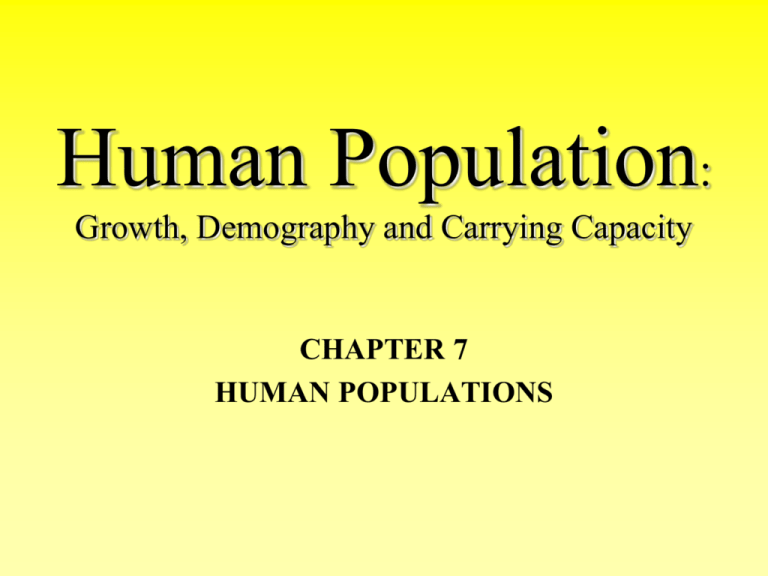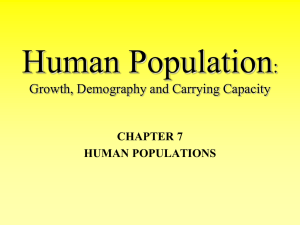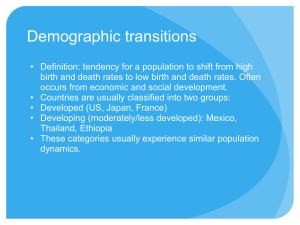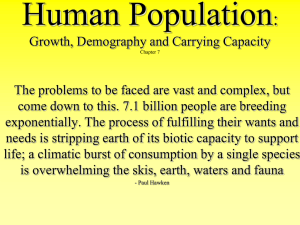Human_Population
advertisement

Human Population: Growth, Demography and Carrying Capacity CHAPTER 7 HUMAN POPULATIONS “20 and Counting” • http://www.youtube.com/watch?v=z3C9K2 fVjMA • What are your thoughts? The More the Merrier!!!??? • http://www.youtube.com/watch?v=pdlKVfk 7_iQ&feature=related • http://www.youtube.com/watch?v=b98JmQ 0Cc3k&feature=related Human Population Growth Historically A. Early Hunter Gatherers Nomadic, With a Strong Sense of the Earth 2. Practiced Intentional Birth Control 1. B. Rise of Agriculture 1. Necessary for Survival Animals became extinct via predation and altered habitat b. Humans began to cultivate own food a. C. Agriculture Gives Rise to Cities 1. Food Produced in Country, Consumed in City a. b. Food wastes are no longer returned to soil Soil becomes less productive Waste of Populations Concentrated in Cities 3. Population Control in Medieval Societies 2. a. b. Infanticide Plagues D. Industrialization 1. View of Children During Early Phases of Industrial Growth Valued as cheap source of income and cheap labor b. Exponential growth of populations a. 2. By 1900s, Birth Rate in Industrialized World Dropped Rise in standards of living b. Safe and inexpensive means of birth control introduced c. Increase in the cost of child rearing a. Current World Population • Population Clock Vital Events (per time unit) Global population was 6,669,203,826 On February 27, 2007 at 6:13 am • The global population grows by: – Nearly 2.3 persons per seconds – Nearly 8,343 persons per hour – Over 200,234 persons per day – Over 73 million persons per year How Much is a Billion? • 1,000 seconds = 16.7 minutes • 1 million-s = 16,677 min = 11.6 days • 1 billion-s = 11,574 days = 31.7 years • 1,000 pennies = ~ 88 ounces = 5.5 pounds • 1 million pennies = 5,500 pounds (~1-Suburban) • 1 billion pennies = 2,750 tons (~2 Space Shuttles) 10000 developed countries less developed countries 8000 M I L 6000 L I O N 4000 S 2000 0 1750 1950 1995 2025 2100 Factors which Impact Populations Developing Countries • Poorer countries • Lower life expectancy • High Birth Rates • Higher Death Rates • Not industrialized • Education – males only • Unstable governments • Higher % of disease • Technology is lacking Developed Countries • Richer (affluent) countries • Higher life expectancy • Low Birth Rates • Low Death Rates • Highly industrialized • Better educated citizens • Better technology • Stable governments • Healthcare Population Projections Over 95% of this increase will take place in “Developing Countries” Countries Comparison Developing Countries • Afghanistan • Bangladesh • Belize • Ethiopia • Tonga • Tunisia • Peru Developed Countries • United States • Germany • Japan • Europe • Sweden • Lichtinstein • Ireland • Canada Population Pyramids • Graphic device: bar graph • shows the age and gender composition of a region • horizontal axis: gender – male: left-hand female: right-hand – absolute number of people or % • vertical axis: age – 5-year or 10-year age groups Factors affecting pop pyramids Medicine Disease Technology War Baby Boomers Natural Disasters • Women deciding to delay family • More attention to health (graying of America) • Gay population increasing!! (~1-5%) • Immigration / emigration Population Pyramid with young cohorts 85 OR 80-84 75-79 70-74 65-69 60-64 55-59 50-54 45-49 female male 40-44 35-39 30-34 Male cohorts Female cohorts 25-29 20-24 15-19 10-14 5-9 0-4 -500 -400 -300 -200 -100 0 100 200 300 400 500 Population Pyramids • Population Pyramids on the Web • High Growth: Afghanistan • Moderate Growth: Mexico • Zero Growth: France, Russia • Negative Growth: Austria or Italy Bottom Graph: Projected population pyramid for 2025 when one can again see the large cohorts that were born between 1985 and 1990. This large number of births is just the “echo effect” of the baby boom bet mid 1960’s and mid-1970’s. Each couple should only have one child according to government policy—so why is the base so large? Top Graph: China’s baby boom that peaked in late 1960’s and early 1970’s. Started in 1950’s-now visible as those generations in 2000 were 45-49 years of age. Middle Graph: Birth cohorts rapidly declined. Children born bet 25-29 in 2007 belonged to the smallest birth cohorts after the baby boom. These ind were born bet 1978 & 1985 when family planning took place. Population Pyramids • Population Pyramids on the Web • High Growth: Afghanistan • Moderate Growth: Mexico • Zero Growth: U.S. • Negative Growth: Austria or Italy Population Pyramids • Population Pyramids on the Web • High Growth: Afghanistan • Moderate Growth: Mexico • Zero Growth: U.S. • Negative Growth: Austria or Italy Population Pyramids • Population Pyramids on the Web • High Growth: Afghanistan • Moderate Growth: Mexico • Zero Growth: U.S. • Negative Growth: Italy Human Population Dynamics • There are just three sources of change in population size — 1. Fertility (Birth rates) 2. Mortality (Death rates) A. "natural decrease" refers to population decline resulting from more deaths than births 3. Net migration - is the number of immigrants minus emigrants Rates of Global Pop. Change use: International Data Base http://www.census.gov/ipc/www/idbnew.html, then Online Demographic Aggregation • CBR (crude birth rate) = # births / 1000 population 1990: 24 now: 20.6 • CDR (crude death rate) = # deaths / 1000 population 1990: 9 now: 8.8 Human Population Dynamics • Total fertility rate (TFR) – – – – The average number of children born to a woman Average in developed countries = 1.5 Average in developing countries = 3.8 Worldwide 1990: 3.1 now: 2.76 On each of the country lines, there is a graph representing that country’s fertility rate. As I scroll down the country list, look at the trends of each of the countries and their fertility rates. Identify the trends. – http://data.worldbank.org/indicator/SP.DYN.TFRT.IN Total Fertility Rate Total Fertility Replacement Rate = The number of children a couple must have to replace themselves (i.e. 2 children) - Also known as replacement-level fertility – A TFR of 2.1 for developed countries with low infant and child mortality rates – Africa RFR = 2.5 children per couple – Mali RFR = 2.7 (ties in with the growth rate—see later) Source: http://geography.about.com/od/populationgeography/a/fertilityrate.htm Mali located in Africa Human Population Dynamics • infant mortality rate (IMR) • infant deaths per 1000 live births (infant < 1 yr) – 1990: 62 now: 52.4 (normal in 1900: 200) http://www.povertymap.net/pub/mipwa/sections/w-global/health-sanit/infant-mortality2.htm What Is Family Planning? A. Definition 1. Measures enabling parents to control number of children (if they so desire) B. Goals of Family Planning 1. Not to limit births 2. For couples to have healthy children 3. For couples to be able to care for their children 4. For couples to have the number of children that they want What Methods are Used to Control Births? A. Preconception Birth Control Methods 1. Barrier Methods a. b. c. d. Condom Vaginal sponge Diaphragm Spermicides 2. Hormonal Contraceptives a. b. Pill Injections and implants 3. Sterilization B. Postconception Birth Control Measures 1. Intrauterine Device 2. RU-486 Pill 3. Abortion Contraceptive Use Worldwide People in industrialized countries enjoy easy access to contraceptives while those in LDCs do not. 2. In the U.S., teens and poor women are least likely to use contraceptives. 3. Severe problems are associated with teen pregnancy. 1. www.tte-online.com/.../table-of-contents/ chem-enc-1.html Maternal Deaths per 100,000 Live Births Source: WHO, UNICEF, UNFPA Maternal Mortality in 1995: Estimates Developed by WHO, UNICEF AND UNFPA, 2001. Growth Rate • The average annual rate of change for a population within a specified time period. Noted in a percentage. • Growth Rate = (b + i) – (d + e) Total Population (births + immigration) – (deaths + emigration) 1990: 1.5% now: 1.19% – growth rates have come down • • • Overall, the world population is growing at a rate of about 1.7 per cent; if this rate continues, the population will double in 42 years. Unabated, such a rate would lead to a point about 2000 years hence when the mass of humanity would weigh more, and be larger, than the Earth. But, the growth rate is decreasing Rule of 70 • Rule of 70 – standard to determine how long it takes for a population to double. • Focus on: migration, aging, youth bulge, urbanization and new socio-economicpolitical consequences. • Some countries will double—some will not. • World is in j-curve growth. Rule of 70 • Assume that the pop doubles every 70 years. • Problem: If the population has a growth rate of 2%, how long will it take for the population to double? • Answer: 70/2 = • 35 years to double. Demographic Transition • • Movement of a nation from high population growth to low population as it develops economically Transition as a result of four stages – – – – Stage 1—Birth and death rates are both high Stage 2—Death rates fall; birth rates remain high; growth rate rises Stage 3—Birth rates fall as standard of living rises; growth rate falls Stage 4—Growth rate continues to fall to zero or to a negative rate The Demographic Transition Five Stages of the Demographic Transition • Used to be 4, now 5 stages • birth rates, death rates and growth rates systematically change through time as societies change: – modernize, urbanize – gain access to technology Population Pyramids and Demographic Stages • characteristics shapes of ‘pyramids’ – – – – wide base (true pyramid) wide middle (bulge), somewhat wider base urn- or bottle-shaped reversed pyramid • different shapes--different dynamics Stage 1: Pre-Industrial • high birth rates, high (at time erratic) death rates, low growth rates • stage for much of human history, traditional societies • practically no country today Stage 2 TRANSITIONAL • high birth rates, declining death rates, rising growth rates • improvements in sanitation (water) and medicine • in Europe during Industrial Revolution • in developing countries since the 50s/60s • much of Africa today, some countries of Asia (Afghanistan, Nepal, etc.) Population Pyramid and Demographic Transition • Stage 2: wide base • stage 3: wide middle • stage 4: slender • stage 5: narrow base Stage 3 • • • • INDUSTRIALIZED continued decline of death rates, declining birth rates, growth rates decline from high to lower levels change in behavior: adaptation to lower death rate, in particular infant mortality rate economic change: urbanization (incentive to have fewer children) Mexico today Population Pyramid and Demographic Transition • Stage 2: wide base • stage 3: wide middle • stage 4: slender • stage 5: narrow base Stage 4 & 5 POST-INDUSTRIALIZED • Stage 4: low birth rates, low death rates, low growth rates – United States today • Stage 5: low birth rates, rising death rates, declining growth rates (if birth rates drop below death rates: negative growth rates) – several countries of Europe today (Austria) Population Pyramid and Demographic Transition • Stage 2: wide base • stage 3: wide middle • stage 4: slender • stage 5: narrow base Population Pyramid and Demographic Transition • Stage 2: wide base • stage 3: wide middle • stage 4: slender • stage 5: narrow base 2010 Stage 2 to Stage 4 China-Stage 2 to Stage 5? What does this mean to you? China Current Population Trends The Graying of Japan • Family-planning access, cramped housing, expensive land, late marriage, education cost --> voluntary decrease in birth rate • Low immigration rate • Health insurance and pension - 45% of national income; could -->low economy • Illegal immigration bolsters work force Influencing Population Size • Most countries restrict immigration – Canada, Australia, U.S. - most immigration • Involuntary immigration results from – armed conflict – environmental degradation – natural disaster --> environmental refugees • ~1% of developing nations pop. Emigrates • Migration from rural to urban areas Family Planning: reduce births and abortions • 59% contraceptive use in developed countries -46% overall, up from 10% in 60s • FP reduces children's social services needs • FP reduces risk of childbearing deaths • FP effectiveness depends on program design and funding: – good in some counties with good program – poor in other counties Family Planning: reduce births and abortions -2 • Services not always accessible; add female teenagers and sexually active unmarried • Add birth control for men (sperm-killing device used in China) • If developed countries provided $17 billion/ year, and each person pays $4.80/year, average family size would be 2.1 and world population would be 2.9 billion







